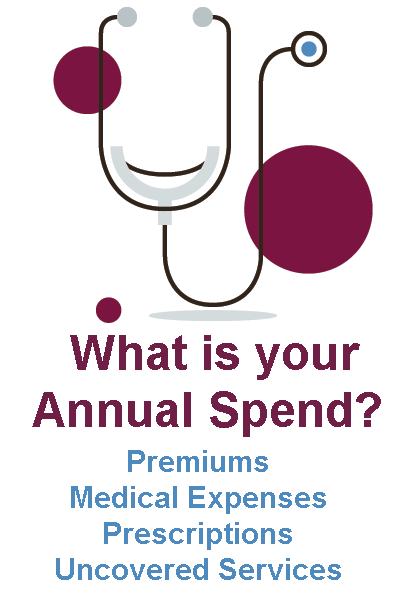I recently set out to buy a new computer bag. It is a rather arbitrary purchase in the scope of life. But, I identified specific criteria for the purchase. It had to accommodate my 17″ MacBook Pro. I wanted it to be “checkpoint-friendly” at the airport. And, I wanted it to have the look of a purse or handbag (rather than a briefcase or messenger bag). I searched countless sites: reading reviews, comparing prices, checking-off my desired criteria. After several days and countless searches, I made my purchase. I suspect many of us have gone through a similar buying experiences for cars, electronics, appliances or even just the perfect gadget. But, how many of us really treat our health care decisions in this way? Most of us are simply patients waiting for a doctor to tell us what the next step is rather than an engaged healthcare consumer.
What will it take for us to treat health care benefits and health care costs like other consumable items? Are you ready to take the first step to becoming a smart healthcare consumer?
 STEP 1: Set your health plan and medical care criteria.
STEP 1: Set your health plan and medical care criteria.
The first step to becoming a smart healthcare consumer is understanding what is important to you and creating a personal health plan. You will want to consider both your health insurance choices and your medical care preferences. Often, there are one or two factors that will define your healthcare path.
Health insurance questions to ask:
 How much can I expect to spend annually? When comparing options you should factor in employee premiums, anticipated medical expenses, prescription drug costs, and contributions and tax savings from a pre-tax benefit account. Be sure to annualize these numbers and consider what benefits might carryover. A health plan with a heavy co-pay structure is likely to have a higher defined cost. However, at the end of the plan year, there is no refund for low utilization. Alternatively, a high deductible health plan may have a lower defined cost up front but is more unpredictable when expenses occur. Calculate your annual spend under each option assuming the best case, likely case and worst case scenarios. This will help you understand the differences between plans and where your risk tolerance is.
How much can I expect to spend annually? When comparing options you should factor in employee premiums, anticipated medical expenses, prescription drug costs, and contributions and tax savings from a pre-tax benefit account. Be sure to annualize these numbers and consider what benefits might carryover. A health plan with a heavy co-pay structure is likely to have a higher defined cost. However, at the end of the plan year, there is no refund for low utilization. Alternatively, a high deductible health plan may have a lower defined cost up front but is more unpredictable when expenses occur. Calculate your annual spend under each option assuming the best case, likely case and worst case scenarios. This will help you understand the differences between plans and where your risk tolerance is.- What are my covered benefits and who are my in-network providers? You will want to have an understanding of what benefits are covered and who your in-network providers are under each plan. This helps define your likely expenses and preferred options for medical services. Some plans provide a very narrow or small network in order to limit costs. If a specific health care provider is important to you, you will want to verify if one plan over another includes this provider.
- What is my plan to pay out-of-pocket medical costs? There is no denying that out-of-pocket medical expenses are on the rise. Employees should leverage pre-tax benefit accounts such as a Medical FSA or Health Savings Account to pay for these expenses. It is, however, important that you understand which account will work best for you and your health plan. Check out the FSA vs. HSA infographic for a quick look.
Considerations regarding medical care:
While emergency services are often selected on your behalf given set conditions, you are able to direct most of your medical care and services. Here are some of the most common considerations:
- What role does location play in your selection of medical care? Are you willing to travel to receive medical services? Will you define your medical care by a set regional area?
- What services do you need? How do price and quality play into your decision-making? What experience does a medical provider have with your specific condition?
- Are there any external or personal factors that would limit/affect your choices in medical care?
 STEP 2: Healthcare Shopping. Complete your research and identify your options.
STEP 2: Healthcare Shopping. Complete your research and identify your options.
Researching your health care options isn’t black and white, but the pay-offs can be significant. Depending on the nature of the medical care you need to receive, there is a variety of research you may pursue. What better way to be a healthcare consumer than to do a little healthcare shopping?
- Research your condition or procedure. Sites, such as WebMD and MayoClinic, have made it easier for individuals to research and understand their medical conditions. These resources guide you on when a condition requires medical attention, what potential options exist and questions you should ask your health care provider. Being informed is necessary to becoming a smart healthcare consumer.
- Research providers and facilities. The costs of services and providers can vary widely. The more you understand about the cost and quality of providers, the more you do yourself a favor controlling medical bills. Healthcare Bluebook offers a “Fair Price Comparison” tool. It outlines the “Fair Price” you can anticipate paying for a given service in a specific location, along with the known price range. Companies, such as MyMedicalShopper, will partner with employers to provide expert analysis and slick consumer tools to aid in healthcare comparison shopping. Their website and mobile apps make it as easy as Google search to shop for medical tests and procedures. Additionally, many health insurance providers will offer price comparison resources. Price transparency can be a challenge, but there are a number of resources available to aid in this process.
- Consider alternatives. If you find yourself defaulting into certain healthcare options, challenge yourself to consider alternatives (or at least ask the questions).
- Save on prescriptions. Ask about generic drugs. Research the costs of specific medications. Good Rx makes it easy to comparison shop for prescriptions and offers discounts.
- Save on routine/non-emergency care. Check your local area for quick care health care facilities. These often have a set cost per visit and may include basic tests like a rapid strep test. If you are looking on on-demand healthcare, give telemedicine, such as Doctor On Demand, a try.
![]()
STEP 3: Compare cost and quality
While price transparency is a key component to becoming an engaged healthcare consumer, you must also factor quality in to your decision. Partners Healthcare outlines several criteria and resources to consider when evaluating a hospital. Just a few considerations include: accreditations, achievements, experience treating your condition, and patient satisfaction.
You might also check out Medicare.gov Hospital Compare or the Ultimate Guide to Medicare.
 STEP 4: Engage
STEP 4: Engage
Merriam-Webster defines consumerism as the “promotion of the consumer’s interests.” The key to being a smart healthcare consumer is understanding that you must take an active role in the decisions affecting your healthcare. You must ask questions, do your research, and ask for references or testimonials. You take these steps in so many purchasing decisions. Make it count when it really is a life or death decision.



